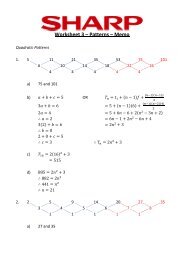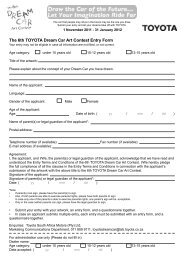curriculum and assessment policy statement (caps) - Department of ...
curriculum and assessment policy statement (caps) - Department of ...
curriculum and assessment policy statement (caps) - Department of ...
- No tags were found...
Create successful ePaper yourself
Turn your PDF publications into a flip-book with our unique Google optimized e-Paper software.
ContinuedSpace <strong>and</strong> ShapeMake <strong>and</strong> complete ownpuzzle (5 pieces)Semi-concrete using 2-D shapesLet the learners:‣ Show learners the flash card with six dots <strong>and</strong> link it to the samenumber <strong>of</strong> counters.‣ Play games identifying a specific number symbol amongstothers <strong>and</strong> link it with the same number <strong>of</strong> counters.‣ Play games identifying a specific number name amongst others<strong>and</strong> link it with the same number <strong>of</strong> counters.‣ Play games by linking the number <strong>of</strong> counters with the numbername, the number symbol <strong>and</strong> the picture cards.‣ Trace the number 6 with a crayon.Let the learners:‣ Draw a picture on an A4 paper.‣ The teacher draws the lines on the back <strong>of</strong> the learner’sdrawing.‣ The learner cuts his/her picture on the given lines.‣ The learner completes his/her own puzzle.Objects or countersFlash card with number symbol <strong>and</strong> number namee.g.Picture<strong>of</strong> 6objects6 sixCrayonsA4 paperCrayonsScissorsEnvelope or self-made bag to place puzzle in (fold A4paper <strong>and</strong> glue sides)Continued1 dayDistinguish between“bigger <strong>and</strong> “smaller.”Underst<strong>and</strong> that thecollecting <strong>and</strong> sorting <strong>of</strong>objects can eventually berepresented in a graph.Compare “shortest <strong>and</strong>tallest “.Estimate the length <strong>of</strong>different objectsDevelop the concept <strong>of</strong>“bigger <strong>and</strong> smaller”• Reinforce the concept <strong>of</strong> “bigger <strong>and</strong> smaller”KinaestheticLet the learners:‣ Make their bodies big by stretching their arms above their head.‣ Make bodies small by bending down <strong>and</strong> curling up.‣ Determine whether a dog is bigger than a mouse.Picture <strong>of</strong> a mouse <strong>and</strong> a dog (ensure that the picture<strong>of</strong> the dog is bigger than the picture <strong>of</strong> the mouse)Concrete using 3-D objectsAlways present at least two objects for comparison.‣ Compare different sizes <strong>of</strong> the same type <strong>of</strong> block, balls, plates,buttons, table, chair etc. <strong>and</strong> determine which objects are“big/small, bigger/smaller” <strong>and</strong>” biggest/smallest”.‣ Build constructions with the building blocks <strong>and</strong> learnerscompare whose construction is the biggest <strong>and</strong> whose is thesmallest.Semi-concrete using 2-D shapes‣ Compare pictures illustrating the concepts <strong>of</strong> big/small <strong>and</strong>bigger/smaller.‣ Apply the concept <strong>of</strong> ‘big/small” during creative art.Objects in the classroom such as blocks, balls, plates,buttons, beads, sticks, pegs, matchboxes, tins,pebbles, corks, shells, bottle tops, etc.Pictures illustrating big/small57 | P age
















